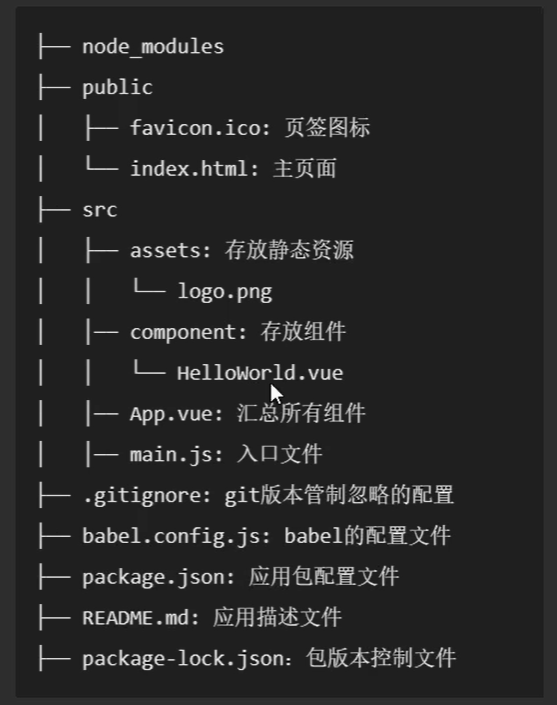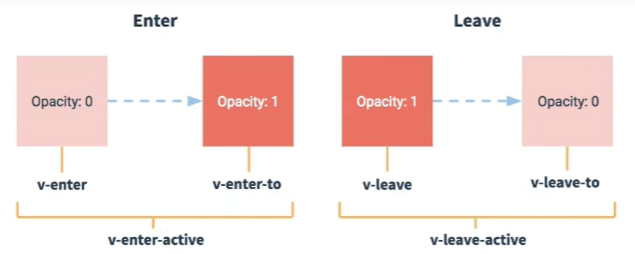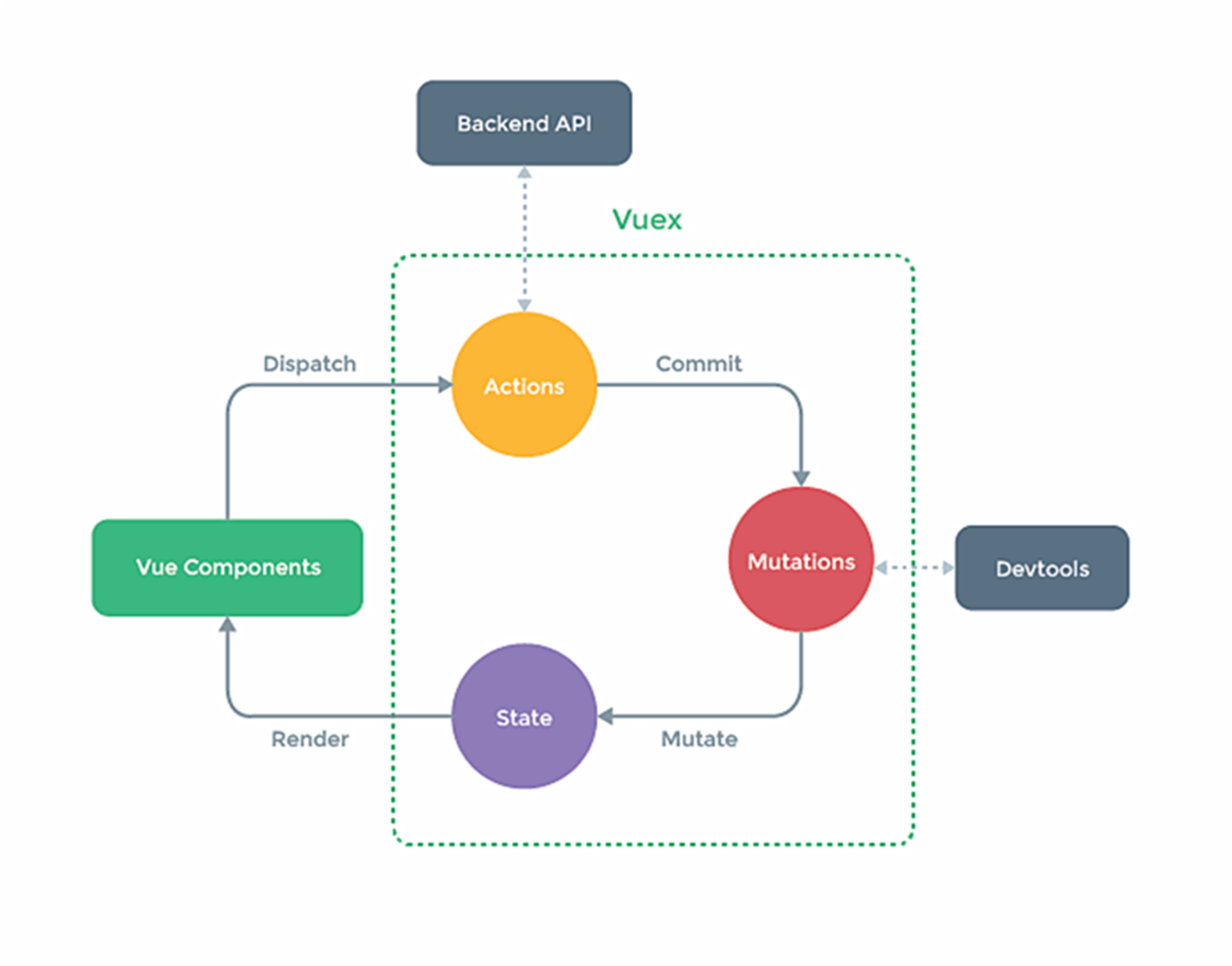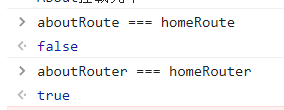Vue2的学习
Vue2
脚手架文件结构
(treer -d 路径)

关于不同版本的Vue说明
vue.js与vue.runtime.xxx.js的区别:
(1) vue.js是完整版的Vue,包含:核心功能+模板解析器。
(2) vue.runtime.xxx.js是运行版的Vue,只包含:核心功能;没有模板解析器。
因为vue.runtime.xxx,js没有模板解析器,所以不能使用templatei配置项,需要使用renderi函数接收到的createElementi函数去指定具体内容。
vue.config.js配置文件
- 使用vue inspect > output.js 可以查看到Vue脚手架的默认配置
- 使用vue.config.js 可以对脚手架进行个性化定制,详情 https://cli.vuejs.org/zh/config/
ref属性
1.被用来给元素或子组件注册引用的信息(id的替代
2.应用在html标签上获取的是真实DOM元素,应用在组件标签上获取的是组件实例对象
3.使用方式:
- 打标识
<h1 ref="title">哈哈</h1> 或者 <School ref="sch"/> - 获取 this.$refs.title啥的
配置项props
功能:让组件接收外部传过来的数据
传递数据:
<Demo name="xxx"/>接收数据:
- 只接收:
props: ['name','sex','age'] - 限制类型:
1
2
3
4
5props: {
name: String,
sex: String,
age: Number
}- 限制类型、限制必要性、指定默认值
1
2
3
4
5
6
7
8
9
10
11
12
13
14props :{
name: {
type: String,//类型
required: true//必须
},
sex: {
type: String,
required: true//默认值
},
age: {
type: Number,
default: 99
}
}- 只接收:
备注:props是只读的。Vue底层会监测你对props的修改,如有修改会发出警告;若业务需求需要改,那么得从props中复制一份到data里,然后去修改data中的那个数据。
mixin-混入
功能:可以吧多个组件供用电额配置提取成一个混入对象
使用方式:
- 第一步定义混合
1
2
3
4
5{
data(){},
methods:{}
……
}- 第二步混入
1
2
3
4局部引入:
mixins:['xxx','yyy']
全局引入:
Vue.mixin(xxx)
插件
- 功能:用于增强Vue
- 本质:包含install方法的一个对象,install的第一个参数是Vue,第二个以后的参数是插件使用者传递的数据
- 定义插件:
1 | 对象.install = function(Vue, options) { |
- 使用插件:
Vue.use()
scoped样式
- 作用:让样式在布局生效,防止冲突
- 写法:
<style scoped></style>
总结TodoList案例
- 组件化编码流程
拆分静态组件:组件按照功能点拆分,命名不要与html元素冲突
实现动态组件:考虑好数据的存放位置,数据是组件在用,还是一些组件在用
- 一个组件在用:放在组件自身即可
- 一些组件在用:放在他们的共同父组件上(状态提升)
实现交互:从绑定事件开始
- props适用于:
- 父组件→子组件 通信
- 子组件→父组件 通信(要求父先给自已个函数)
用v-model时切记:v-model绑定的值不能是props传过来的值,因为props是不可以被修改的!!
props传过来的若是对象类型的值,修改对象中的属性时Vue不会报错,但不推荐这样做。
web Storage
存储内容大小一般5MB左右(不同浏览器不一样)
浏览器通过 Window.sessionStorage 和 Window.localStorage 属性实现本地存储机制
相关API
xxxStorage.setItem('key', 'value'):接受一个键和值作为参数,会把键值对添加到存储中,如果键名存在,更新其对应的值。xxxStorage.getItem('key'):接受一个键名作为参数,返回键名对应的值。xxxStorage.removeItem('key'):接受一个键名作为参数,把该键值从存储中删除。xxxStorage.clear():清空存储中所有的数据。
备注
- SessionStorage存储的内容会随着浏览器窗口关闭而消失
- LocalStorage存储的内容需要手动清除
- setItem如果对应键的值获取不到,那么getItem返回值是null
JSON.parse(null)结果依然是null
组件的自定义事件
一种组件间的通信方式,适用于:子组件=>父组件
使用场景:A是父组件,B是子组件,B想给A传数据,那么就要在A中给B绑定自定义事件(事件的回调在A中)
绑定自定义事件:
第一种,在父组件中:
<Demo @qvq='test'/>(v-on)第二种,在父组件中:
1
2
3
4
5<Demo ref="demo"/>
......
mounted() {
this.$refs.demo.$on('qvq',this.test)
}若想让自定义事件只触发一次,用
once修饰符,或$once方法
触发自定义事件:
this.$emit('qvq',数据)解绑自定义事件:
this.$off('qvq')组件上也可以绑定原生DOM事件,需要使用
native修饰符注意:通过
this.$refs.xxx.$on('ref值',回调)绑定自定义事件时,回调要么配置在methods中,要么箭头函数怼进去,否则this指向调用它的组件捏。
全局事件总线(GlobalEventBus)
一种组件间通信的方式,适用于任意组件间通信
安装全局事件总线:
1
2
3
4
5
6
7new Vue({
...
beforeCreate() {
Vue.prototype.$bus = this //安装全局事件总线,$bus就是当前应用的vm
},
...
})使用事件总线:
接受数据:A想接收数据,则A组件给$bus绑定自定义事件,事件的回调留在A组件自身。
1
2
3
4
5
6
7
8methods() {
demo(data){....}
}
....
mounted() {
this.$bus.$on('xxx',this.demo)
}
或者用箭头函数提供数据:
this.$bus.$on('xxx',this.demo)
最好在beforeDestroy钩子中,用
$off去解绑当前组件所用到的事件。
消息订阅与发布(pubsub)
一种组件间通信的方式,适用于任意组件间通信
使用步骤:
安装pubsub:
npm i pubsub-js引入:
import pubsub from 'pubsub-js'接受数据:A想收数据,则在A中订阅消息,订阅的回调留在A自己这里
1
2
3
4
5
6
7methods() {
demo(data){....}
}
....
mounted() {
this.pid = pubsub.subscribe('xxx', this.demo)//订阅消息
}提供数据:
pubsub.publish('xxx',数据)最好在beforeDestroy钩子中,用
pubsub.unsubscribe(pid)去取消订阅。
nextTick
- 语法:
this.$nextTick(回调函数) - 作用:在下一次DOM更新结束后执行其指令回调
- 什么时候用:当改变数据后,要基于更新后的新DOM进行某些操作,要在nextTick所指定的回调函数中执行
Vue封装的过度与动画
作用:在插入、更新或移除DOM元素时,在核实的时候给元素添加样式类名
图示:

写法
准备好样式
元素进入的样式
v-enter:进入的起点
v-enter-active:进入的过程中——单用active 可animation:搭配@keyframes animationName {}动画
v-enter-to:进入的终点
元素离开的样式
v-leave:离开的起点
v-leave-active:离开的过程中
v-leave-to:离开的终点
使用
<transition>包裹要过度的元素,并配置name属性1
2
3
4
5<transition name="hello">
<h1 v-show="isShow">
你好啊!
</h1>
</transition>备注:若有多个元素需要过度,则需要用:
<transition-group>,且每个元素指定<key>值1
2
3
4<transition-group name="qvq" appear>
<h1 v-show="isShow" key="1">你好:D</h1>
<h1 v-show="!isShow" key="2">嗨嗨嗨:D</h1>
</transition-group>
vue脚手架配置代理
方法一
在vue.config.js中添加如下配置:
1 | devServer: { |
说明:
1. 优点:配置简单,请求资源时直接发给前端(8080)即可
2. 缺点:不能配置多个代理,不能灵活的控制请求是否走代理
3. 工作方式:若按照上述代理配置,当请求了前端不存在的资源时,那么该请求会专访给服务器(优先匹配前端资源)
方法二
编写vue.config.js配置具体代理规则:
1 | module.exports = { |
说明:
- 优点:可以配置多个代理,且可以灵活的控制请求是否走代理
- 缺点:配置略微繁琐,请求资源时必须加前缀
插槽
作用:让父组件可以向子组件指定位置插入html结构,也是一种组件间的通信方式,适用于 父组件=>子组件
分类:默认插槽,具名插槽,作用域插槽
使用方式
默认插槽
1
2
3
4
5
6
7
8
9
10
11
12
13父组件中:
<Category>
<div>
html结构1
</div>
</Category>
子组件中:
<template>
<div>
<!--定义插槽-->
<slot>插槽默认内容...</slot>
</div>
</template>具名插槽
1
2
3
4
5
6
7
8
9
10
11
12
13
14
15
16
17
18
19
20
21父组件中:
<Category>
<template slot="center">
<div>
html结构1
</div>
</template>
<template slot="footer">
<div>
html结构2
</div>
</template>
</Category>
子组件中:
<template>
<div>
<!--定义插槽-->
<slot name="center">插槽默认内容</slot>
<slot name="footer">插槽默认内容</slot>
</div>
</template>作用域插槽
理解:数据在组件的自身,但数据生成的结构需要组件的使用者来决定。(game数据在Category组件中,但是用数据所遍历出来的结构由APP组件决定)…….当然它也可以具名
具体编码:
1
2
3
4
5
6
7
8
9
10
11
12
13
14
15
16
17
18
19
20
21
22
23
24
25
26
27
28
29
30
31
32
33
34
35
36
37
38
39父组件中:
<Category>
<template scope="scopeData">
<ul>
<li v-for="g in scopeData.games" :key="g">{{g}}</li>
</ul>
</template>
</Category>
<Category>
<template slot-scope="scopeData">
<ol>
<li v-for="g in scopeData.games" :key="g">{{g}}</li>
</ol>
</template>
</Category>
<Category>
<template scope="{games}">
<h4 v-for="g in games" :key="g">{{g}}</h4>
</template>
</Category>
子组件中:
<template>
<div>
<slot :games="games">默认</slot>
</div>
</template>
<script>
export default {
name: 'Category',
props: ['title'],
//数据在子组件自身
data() {
return {
games: ['原神', '使命召唤', '赛特斯2']
}
}
}
</script>
Vuex

1.概念
在Vue中实现集中式状态(数据)管理的一个Vue插件,对vue应用中多一个组件的共享状态进行集中式管理(读/写),也是一种组件间的通信方式,切实用于任意组件间的通信。
2.何时使用
多个组件需要共享数据时。
3.搭建vuex环境
创建文件:
src/store/index.js1
2
3
4
5
6
7
8
9
10
11
12
13
14
15
16
17
18
19
20
21
22//该文件用于创建Vuex中最为核心的store
//引入Vue核心库
import Vue from 'vue'
//引入Vuex
import Vuex from 'vuex'
//使用Vuex插件
Vue.use(Vuex)
//准备actions,用于响应组件中的动作
const actions = {}
//准备mutations,用于操作数据(state)
const mutations = {}
//准备state,用于存储数据
const state = {}
//创建并暴露store
export default new Vuex.Store({
actions,
mutations,
state,
})在
main.js中创建vm时传入store配置项1
2
3
4
5
6
7
8
9
10....
//引入store
import store from './store'
....
//创建vm
new Vue({
el:'#app',
render: h => h(App),
store
})
4.基本使用
初始化数据,配置
actions配置mutations操作文件store.js1
2
3
4
5
6
7
8
9
10
11
12
13
14
15
16
17
18
19
20
21
22
23
24
25
26
27
28
29
30
31//引入Vue核心库
import Vue from 'vue'
//引入Vuex
import Vuex from 'vuex'
//引用Vuex
Vue.use(Vuex)
const actions = (
//响应组建的加
increase(context, value) {
context.commit('INCREASE', value)
},
)
const mutations = {
///执行加
INCREASE(state,value) {
state.sum += value
}
}
const state = {
//初始化数据
sum: 0
}
export default new Vuex.Store({
actions,
mutations,
state,
})组建中读取vuex中的数据:
$store.state.sum组建中修改vuex中的数据:
$store.dispatch('action中的方法名', 数据)或$store.commit('mutations中的方法名', 数据)备注:若没有网络请求或其他业务逻辑,组件中也可以越过actions,即不写
dipatch,直接commit
5.getter的使用
概念:当state中的数据需要经过加工后再使用时,可以使用getters加工。
在
store.js中追加getters配置1
2
3
4
5
6
7
8
9
10
11....
const getters = {
bigSum(state) {
return state.sum*10//这里假装一波复杂运算
}
}
//创建并暴露
export default new Vuex.Store({
....
getters
})组件中读取数据:
$store.getters.bigSum
6.四个map方法的使用
mapState方法:用于帮助我们映射
state中的数据为计算属性。1
2
3
4
5
6
7
8
9
10
11computed: {
//借助mapState生成计算属性,从state中读取数据(对象写法)
...mapState({//...解构赋值,把对象里的东西展开
'sum': 'sum',//规范'sum',图个简单↓
school: 'school',
kecheng: 'subject',
}),
//借助mapState生成计算属性,从state中读取数据(数组写法)
...mapState(['sum', 'school', 'subject']),
}mapGetters方法:用于帮助我们映射
getters中的数据为计算属性。1
2
3
4
5
6
7computed: {
//借助mapGetters生成计算属性,从getters中读取数据(对象写法)
...mapGetters({bigSum: 'bigeSum'}),
//借助mapGetters生成计算属性,从getters中读取数据(数组写法)
...mapGetters(['bigSum']),
}mapActions方法:用于帮助我们生成与
actions对话的方法,即:包含$store.dispatch(xxx)的函数。1
2
3
4
5
6
7methods: {
//借助mapActions生成对应的方法,方法中会调用despatch去联系actions(对象写法)——它自动生成的是func(value){},所以说在调用的时候要传参,这样是相较于再从methods里面调方法更简单的
...mapActions({increamentOdd: 'increaseOdd', increamentWait: 'increaseWait'}),
//借助mapActions生成对应的方法,方法中会调用despatch去联系actions(数组写法)——注意这里只能是actions中的名,那么前面调用就得用这种
...mapActions(['increamentOdd', 'increamentWait']),
}mapMutations方法:用于帮助我们生成与
mutations对话的方法,即:$store.commit(xxx)的函数。1
2
3
4
5
6methods: {
//借助mapMutations生成对应的方法,方法中会调用commit去联系mutations(对象写法)——它自动生成的是func(value){},所以说在调用的时候要传参,这样是相较于再从methods里面调方法更简单的
...mapMutations({increament: 'INCREASE', decreament: 'DECREASE'}),
//借助mapMutations生成对应的方法,方法中会调用commit去联系mutations(数组写法)——注意这里只能是mutations中的名,那么前面调用就得用这种
...mapMutations(['INCREASE', 'DECREASE']),
}备注:mapActions与mapMutations使用时,若需要传递参数,需要:在模板中绑定事件时传递好参数,否则参数是事件对象。
7.模块化+命名空间
目的:让代码更好的维护,让多种数据分类更加明确。
修改
store.js(这里直接份文件了)count.js
1
2
3
4
5
6
7
8
9
10
11//求和相关的配置
...
const countOptions = {
namespaced: true,//开启命名空间,不想麻烦一定要写!
actions: {...},
mutations: {...},
state: {...},
getters: {...}
}
export default countOptionsperson.js
1
2
3
4
5
6
7
8
9
10
11//人名相关的配置
...
const personOptions = {
namespaced: true,
actions: {...},
mutations: {...},
state: {...},
getters: {...}
}
export default personOptionsindex.js
1
2
3
4
5
6
7
8
9
10
11
12
13
14
15
16
17
18
19
20//该文件用于创建Vuex中最为核心的store
//引入Vue
import Vue from 'vue'
//引入Vuex
import Vuex from 'vuex'
//引入俩模块
import countOptions from './count'
import personOptions from './person'
//使用Vuex插件
Vue.use(Vuex)
//浅浅暴露一下
export default new Vuex.Store({
modules: {
countAbout: countOptions,//简写也行
personAbout: personOptions
}
})开启命名空间后,组件中读取state数据:
1
2this.$store.state.personAbout.list//自己读
...mapState('countAbout', ['sum', 'school', 'subject'])//借助mapState读开启命名空间后,组件中读取state数据:
1
2this.$store.getters['personAbout/firstPersonName']//自己读
...mapState('countAbout', ['bigSum'])//借助mapGetters读开启命名空间后,组件中调用dispatch:
1
2this.$store.dispatch('personAbout/addPersonWang', person)//自己调用
...mapActions('countAbout', {increaseOdd: 'jiaOdd', increasementWait: 'jiaWait'})//借助map.Actions调用开启命名空间后,组件中调用commit:
1
2this.$store.commit('personAbout/ADD_PERSON', person)//自己调用
...mapMutations('countAbout', {increasement:'JIA', decreasement:'JIAN'})
路由
- 理解:一个路由(route)就是一组映射关系,多个路由需要路由器(router)进行管理
- 前端路由:key是路径,value是组件
1.基本使用
安装vue-router,命令
npm i vue-router应用插件:
Vue.use(VueRouter)编写router配置项
1
2
3
4
5
6
7
8
9
10
11
12
13
14
15
16
17
18
19
20//引入VueRouter
import VueRouter from 'vue-router'
//引入路由组件
import About from '../components/About'
import Home from '../components/Home'
//创建router实例对象,去管理一组一组的路由规则
const router = new VueRouter({
routes: [
{
path: './about',
component: About
},
{
path: './home',
component: Home
}
]
})
//暴露router
export default router实现切换(active-class可配置高亮样式)
1
<router-link active-class="active" to="/about">About</router-link>
指定展示位置
1
<router-view></router-view>
2.几个注意点
路由组件通常存放在
pages文件夹,一般组件通常存放在components文件夹通过切换,“隐藏”了路由组件,默认是被销毁掉的,需要的时候再去挂载
每个组件都有自己的
$route属性,里面存储自己的路由信息整个应用只有一个
router,可以通过$router属性获取到
3.多级路由(嵌套路由)
配置路由规则,使用children配置项:
1
2
3
4
5
6
7
8
9
10
11
12
13
14
15
16routes: [
{ //一级路由
path: './home',
component: Home,
children: [
{ //这个地方一定不要加斜杠,因为已经帮着加了
path: 'news',
component: News
},
{
path: 'message',
component: Message
}
]
}
]跳转(要写完整路径):
1
<router-link to:'/home/news'>News</router-link>
4.路由传参
传递参数
1
2
3
4
5
6
7
8
9
10
11
12
13<!-- 跳转路由并携带query参数,to的字符串写法 -->
<router-link :to="`/home/message/detail?id=${m.id}&title=${m.title}`">跳转</router-link>
<!-- 跳转路由并携带query参数,to的对象写法 -->
<router-link
:to="{
path: '/home/message/detail',
query: {
id: m.id,
title: m.title,
},
}">跳转
</router-link>接收参数
1
2$route.query.id
$route.query.title
5.命名路由
作用:可以简化路由的跳转
如何使用
给路由命名
1
2
3
4
5
6
7
8
9
10
11
12
13
14
15
16
17
18
19
20
21
22
23
24
25
26
27
28
29
30
31
32
33routes: [
//一级路由
{
name: 'guanyu',
path: '/about',
component: myAbout,
},
{
name: 'jia',
path: '/home',
component: myHome,
children: [
{
name: 'xiaoxi',
path: 'news',
component: myNews,
},
{
name: 'message'
path: 'message',
component: myMessage,
children: [
{
name: 'detail',
path: 'detail',
component: myDetail,
}
]
}
]
},
]简化跳转
1
2
3
4
5
6
7
8
9
10
11
12
13
14
15
16简化前,需要写完整路径
<router-link class="list-group-item" active-class="active" to="/home/message">Message</router-link>
简化后,直接通过名字跳转
<router-link class="list-group-item" active-class="active" :to="{name: 'xiaoxi'}">News</router-link>
简化写法配合传递参数
<router-link
:to="{
name: 'xiangqing',
query: {
id: m.id,
title: m.title,
},
}" > 跳转
</router-link>
6.params参数
配置路由,声明接收params参数
1
2
3
4
5{
name: 'xiangqing',
path: 'detail/:id/:title',
component: myDetail,
}传递参数
1
2
3
4
5
6
7
8
9
10
11
12
13<!-- 跳转路由并携带params参数,to的字符串写法 -->
<router-link :to="`/home/message/detail/${m.id}/${m.title}`">跳转</router-link>
<!-- 跳转路由并携带params参数,to的对象写法 -->
<router-link
:to="{
name: 'xiangqing',
//这个地方就必须得用name了
params: {
id: m.id,
title: m.title,
}">跳转
</router-link>接收参数
1
$route.params.id
7.路由props配置
作用:让路由组件更方便收到参数
哈哈超级不喜欢params
1 | { |
8.<router-link的replace属性
作用:控制路由调好钻时操作浏览器历史记录的模式
浏览器的历史记录有两种写入方式
- push,追加历史记录(默认)
- replace,替换当前记录
如何开启replace模式
<router-link repalce>News</router-link>OR<router-link :repalce="true">News</router-link>
9.编程式路由导航
作用:不借助
<router-link>实现路由跳转,让路由跳转更加灵活(因为会转化成<a>呀)具体编码:
1
2
3
4
5
6
7
8
9
10
11
12
13
14
15
16
17
18
19
20
21
22
23
24
25
26
27
28
29
30
31
32
33methods: {//按钮啥的
pushShow(m) {
this.$router.push({
name: "xiangqing",
query: {
id: m.id,
title: m.title,
},
});
},
replaceShow(m) {
this.$router.replace({
name: "xiangqing",
query: {
id: m.id,
title: m.title,
},
});
},
},
methods: { //前进后退啥的
back() {
this.$router.back()
},
forward() {
this.$router.forward()
},
go() {
//向前走n步
this.$router.go(-2)
}
},
10.缓存路由组件
组件:让不展示的路由组件保持挂载,不被销毁
具体编码:
1
2
3<keep-alive include="组件名">
<router-view></router-view>
</keep-alive>
11.三个新的生命周期钩子
作用:路由组件所独有的两个钩子,用于捕获有路由组件的激活状态
具体名字:
activated路由组件被激活时触发deactivated路由组件失活时触发
还有一个叫
nextTick
12.路由守卫
作用:对路由进行权限控制
分类:全局守卫、独享守卫、组件内守卫
全局守卫:
1
2
3
4
5
6
7
8
9
10
11
12
13
14
15
16
17//全局 前置 路由守卫:初始化时/每一次路由切换之前调用
router.beforeEach((to,from,next) => {
if(to.meta.isAuth) {//判断是否需要鉴权
if(localStorage.getItem('school') === 'qust') {
next()
}else {
alert('当前用户无权限查看')
}
}else {
next()
}
})
//全局 后置 路由守卫:初始化时被调用/每次路由切换之后被调用
router.afterEach((to,from) => {
document.title = to.meta.title || '哈哈哈'
})独享守卫:
1
2
3
4
5
6
7
8
9
10
11beforeEnter: (to,from,next) => {
if(to.meta.isAuth) {//判断是否需要鉴权
if(localStorage.getItem('school') === 'qust') {
next()
}else {
alert('当前用户无权限查看')
}
}else {
next()
}
}组件内守卫:
1
2
3
4
5
6
7
8
9
10
11
12
13
14
15
16//进入守卫-组件路由守卫,通过路由规则,进入该组件时被调用
beforeRouteEnter(to,from,next) {
if(to.meta.idAuth) {
if(localStorage.getItem('school') === 'qust') {
next()
}else {
alert('该用户无权访问')
}
}else{
next()
}
},
//离开守卫-组件路由守卫,通过路由规则,离开该组件时被调用
beforeRouteLeave(to,from,next) {
next()
}
13.路由器的两种工作模式
- 对于一个url来说,什么是hash值?——#及其后面的内容就是hash值
- hash值不包括在http请求中,即:hash值不会带给服务器
- hash模式:
- 地址中永远带着#号,不美观
- 若以后将地址通过第三方手机app分享,若app校验严格,则地址会被标记为不合法
- 兼容性较好
- history模式:
- 地址干净,美观
- 兼容性和hash模式相比略差
- 应用部署上线时需要后端人员支持,解决刷新页面服务器404的问题
Vue UI组件库
移动端常用UI组件库
- Vant
- Cube UI
- Mint UI
PC端常用UI组件库
- Element UI
- IView UI


